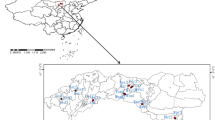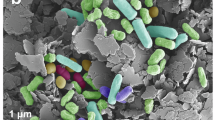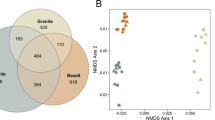Abstract
Clay minerals, charcoal and metal oxides are essential parts of the soil matrix and strongly influence the formation of biogeochemical interfaces in soil. We investigated the role of these parental materials for the development of functional microbial guilds using the example of alkane-degrading bacteria harbouring the alkane monooxygenase gene (alkB) in artificial mixtures composed of different minerals and charcoal, sterile manure and a microbial inoculum extracted from an agricultural soil. We followed changes in abundance and community structure of alkane-degrading microbial communities after 3 and 12 months of soil maturation and in response to a subsequent 2-week plant litter addition. During maturation we observed an overall increasing divergence in community composition. The impact of metal oxides on alkane-degrading community structure increased during soil maturation, whereas the charcoal impact decreased from 3 to 12 months. Among the clay minerals illite influenced the community structure of alkB-harbouring bacteria significantly, but not montmorillonite. The litter application induced strong community shifts in soils, maturated for 12 months, towards functional guilds typical for younger maturation stages pointing to a resilience of the alkane-degradation function potentially fostered by an extant ‘seed bank’.
Similar content being viewed by others
Log in or create a free account to read this content
Gain free access to this article, as well as selected content from this journal and more on nature.com
or
References
Babin D, Ding GC, Pronk GJ, Heister K, Kögel-Knabner I, Smalla K . (2013). Metal oxides, clay minerals and charcoal determine the composition of microbial communities in matured artificial soils and their response to phenanthrene. FEMS Microbiol Ecol 86: 3–14.
Chorover J, Kretzschmar R, Garcia-Pichel F, Sparks DL . (2007). Soil biogeochemical processes within the critical zone. Elements 3: 321–326.
Ding G-C, Pronk GJ, Babin D, Heuer H, Heister K, Kögel-Knabner I et al. (2013). Mineral composition and charcoal determine the bacterial community structure in artificial soils. FEMS Microbiol Ecol 86: 15–25.
Epstein SS . (2009). Microbial awakenings. Nature 457: 1083.
Eusterhues K, Rumpel C, Kleber M, Kögel-Knabner I . (2003). Stabilisation of soil organic matter by interactions with minerals as revealed by mineral dissolution and oxidative degradation. Org Geochem 34: 1591–1600.
Giebler J, Wick LY, Chatzinotas A, Harms H . (2013). Alkane-degrading bacteria at the soil-litter interface: comparing isolates with T-RFLP-based community profiles. FEMS Microbiol Ecol 86: 45–58.
Heister K, Höschen C, Pronk G, Mueller C, Kögel-Knabner I . (2012). NanoSIMS as a tool for characterizing soil model compounds and organomineral associations in artificial soils. J Soils Sediments 12: 35–47.
Kaiser K, Guggenberger G . (2003). Mineral surfaces and soil organic matter. Eur J Soil Sci 54: 219–236.
Kögel-Knabner I, Guggenberger G, Kleber M, Kandeler E, Kalbitz K, Scheu S et al. (2008). Organo-mineral associations in temperate soils: Integrating biology, mineralogy, and organic matter chemistry. J Plant Nutr Soil Sci 171: 61–82.
Lehmann J, Rillig MC, Thies J, Masiello CA, Hockaday WC, Crowley D . (2011). Biochar effects on soil biota - A review. Soil Biol Biochem 43: 1812–1836.
Pronk GJ, Heister K, Ding G-C, Smalla K, Kögel-Knabner I . (2012). Development of biogeochemical interfaces in an artificial soil incubation experiment; aggregation and formation of organo-mineral associations. Geoderma 189–190: 585–594.
Pronk GJ, Heister K, Kögel-Knabner I . (2013). Is turnover and development of organic matter controlled by mineral composition? Soil Biol Biochem 67: 235–244.
Schulz S, Giebler J, Chatzinotas A, Wick LY, Fetzer I, Welzl G et al. (2012). Plant litter and soil type drive abundance, activity and community structure of alkB harbouring microbes in different soil compartments. ISME J 6: 1763–1774.
Shade A, Hogan CS, Klimowicz AK, Linske M, McManus PS, Handelsman J . (2012). Culturing captures members of the soil rare biosphere. Environ Microbiol 14: 2247–2252.
Sohi SP, Krull E, Lopez-Capel E, Bol R . (2010). A review of biochar and its use and function in soil. Adv Agron 105: 47–82.
Totsche KU, Rennert T, Gerzabek MH, Kögel-Knabner I, Smalla K, Spiteller M et al. (2010). Biogeochemical interfaces in soil: The interdisciplinary challenge for soil science. J Plant Nutr Soil Sci 173: 88–99.
Vogel C, Mueller CW, Höschen C, Buegger F, Heister K, Schulz S et al. (2014). Submicron structures provide preferential spots for carbon and nitrogen sequestration in soils. Nat Commun 5: 2947.
Vos M, Wolf AB, Jennings SJ, Kowalchuk GA . (2013). Micro-scale determinants of bacterial diversity in soil. FEMS Microbiol Rev 37: 936–954.
Wagai R, Mayer LM . (2007). Sorptive stabilization of organic matter in soils by hydrous iron oxides. Geochim Cosmochim Acta 71: 25–35.
Young IM, Crawford JW . (2004). Interactions and self-organization in the soil-microbe complex. Science 304: 1634–1637.
Acknowledgements
Funding by German Research Foundation in the framework of the priority programme 1315 ‘Biogeochemical Interfaces in Soil’ is greatly acknowledged. Funding of the ‘PILZNETZWERKE’ project by grants from the European Regional Development Fund and Saxony in an initiative of ‘Europe funds Saxony’ is acknowledged. For support in T-RFLP analysis, we are grateful to Katharina Wetzel and for help with NMDS-statistics to Ingo Fetzer. We thank the three anonymous reviewers of the original manuscript for their very helpful and constructive comments for improving the manuscript.
Author information
Authors and Affiliations
Corresponding author
Ethics declarations
Competing interests
The authors declare no conflict of interest.
Additional information
Supplementary Information accompanies this paper on The ISME Journal website
Rights and permissions
About this article
Cite this article
Steinbach, A., Schulz, S., Giebler, J. et al. Clay minerals and metal oxides strongly influence the structure of alkane-degrading microbial communities during soil maturation. ISME J 9, 1687–1691 (2015). https://doi.org/10.1038/ismej.2014.243
Received:
Revised:
Accepted:
Published:
Issue date:
DOI: https://doi.org/10.1038/ismej.2014.243
This article is cited by
-
Soil phyllosilicate and iron oxide inhibit the quorum sensing of Chromobacterium violaceum
Soil Ecology Letters (2021)
-
Bacillus subtilis biofilm development in the presence of soil clay minerals and iron oxides
npj Biofilms and Microbiomes (2017)
-
Interaction of minerals, organic matter, and microorganisms during biogeochemical interface formation as shown by a series of artificial soil experiments
Biology and Fertility of Soils (2017)
-
Direct evidence for microbial-derived soil organic matter formation and its ecophysiological controls
Nature Communications (2016)



